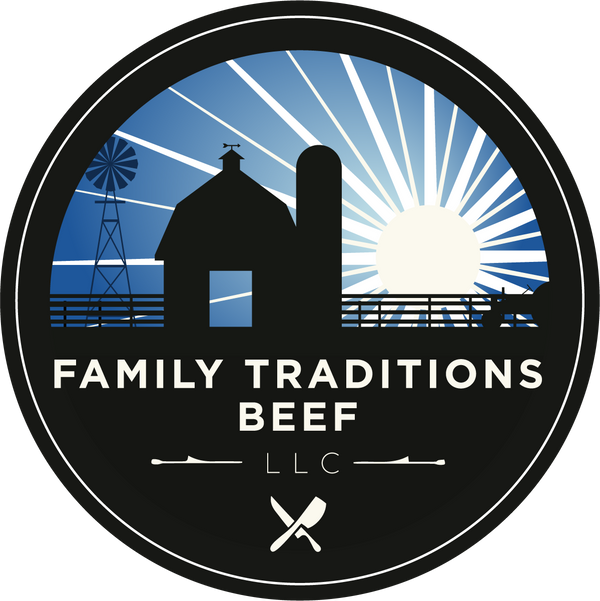We raise our cattle from Birth to Butcher. Does that add any value?? ABSOLUTELY!
To understand what makes our birth to butcher system so attractive, you need to understand the alternative first. Commodity beef like you buy in the grocery store travels A LOT.
Why is this and why does it matter? The beef industry is very segmented and diverse.
Steps in the Beef Chain -
1. Cow/calf producer: These are the folks with mama cows. They are usually located in an area with a lot of grassland and pasture like the south/central/northern plains, and the midsouth/southeast US. Once a year, their cows will give birth to a calf. These cattle producers make sure the cows are well fed and that a calf is born healthy. They typically keep these cattle until about 600 pounds when they are sold at local auction or to a backgrounder.
2. Stocker/Backgrounder: These folks are more like middlemen. They gather groups of smaller cattle, sort them into groups of similar weight, address any health concerns and teach them how to eat out of a feed bunk because they would have mainly had mothers' milk up until this point. They can be located about anywhere in the country but are usually close to a source of cattle. Cattle may be purchased directly from the cow/calf producer or at a sale barn where they are organized at a local auction. These larger groups of cattle weighing 600-750 lbs will be sold to a feedlot.
3. Feedlot: Feedlots purchase groups of cattle to add weight. They are fed a variety of feeds to take the animal from the 700 lb weight to their “finish weight”, somewhere around 1300 lbs per animal. Feeds might include silage (chopped corn plant), grains, protein sources, hay, etc. Feedlots are typically located near sources of animal feed such as the Midwest, plains states. These farms sell cattle directly to a buyer at the process facility.
4. Processor: Processors are the slaughter facility where animals are butchered and packaged. 35 million cattle are processed into about 26 billion pounds each year by 60 major processors. There are four MEGA players in this marketplace: JBS, Tyson, National Beef, and Cargill. These four companies account for about 80% of all the beef processed in the US.
5. Warehousing: These are the cold-storage facilities that link the processor and the consumer. They are often owned by the processor themselves. Products are coordinated and shipped to retail outlets.
6. Retail: You’ll recognize these businesses are restaurants, grocery stores, delis and caterers.
Whew!! Now that we’ve covered all that, what does Family Traditions Beef do?
Everything except #4.
Our family has finished cattle (step #3: feedlot) for several generations. The process was the same as above but on a much smaller scale and our animals have A LOT more room than corporate feed lots.
We started our cow herd in 2015 to have our own source of animals. Our cows give birth to calves in the fall of the year and grow through the next summer. Corn is added to their diet in the finishing phase to a final weight and delivered to our local USDA inspected butcher. After 14 days of dry aging, we pick up our frozen beef so it can be shipped to you.
What’s the issue with commodity beef?
Quality control is tough. When product changes hands, it’s difficult to know the various standards along the way. Issues around animals’ health protocol, welfare, genetics and diet come to mind among others.
Environmental footprint can be huge! Start with a calf born in Virginia, backgrounded in Tennessee, finished in Indiana, processed in Illinois, and retailed in Minneapolis. That’s a LOT of travel and a LOT of diesel fuel.
Comingled hamburger rather than single animal hamburger is commonplace at packing plants. These are businesses based on efficiency for their stockholders, not artisan butchering.
Commodity beef is wet aged. When time is of the essence, you package hamburger on styrofoam, seal it with plastic and send it to the warehouse. Carbon dioxide is added along the way to keep it looking the rosy-red color.
Concerning flavor, wet aging has an acidic flavor while dry aging is more of a roasted flavor.
E-Coli is not killed by wet aging. Wet aging may provide efficiency, but it comes at a cost to human health. Bacteria that is misplaced during the processing of a carcass is the main issue when you see the report of the nightly news about ecoli in beef. Dry aging at the proper temperature and humidity will kill ecoli bacteria.
The “Where’s Waldo” Factor
8-10% of beef consumed in the US is imported from other countries.
Bottom line – cheaper animals are sourced outside the US while many top-tier level US beef is exported to other countries.
How closely do the medications, feed and care standards in each country align with those of the US?
Until there is COOL (Country of Origin Labeling), we will not be able to distinguish the source of our beef in the commodity beef system.
Would you prefer to know everything about where your beef came from??
We can tell you...
its birthday
its mother's name
its grandmothers name
its fathers name
what it ate where it lived (its whole life)
I feel 100 times more confident feeding my family beef when I know everything about it and you can too!
Did you know that your steaks were owned by so many people/businesses before you?? Wouldn't it be nice if you could buy beef that had only been owned by one farmer. You can!
Browse the beef and pork we offer here.
